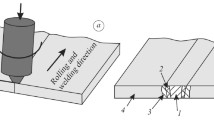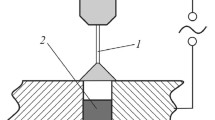We study welded joints of sheets 4 mm in thickness made of D16T alloy (an analog of 2024-Т3 alloy) in the as-delivered state (hardening and natural aging) and after additional artificial aging. The joints are obtained by fusion welding with the use of the pulsed-arc method with consumable electrode (Zv1201). It is shown that, for some modes of heat-treatment of the welded alloy and welded joint, the ratio of strength of the weld and base metals is equal to 0.9. For the weld metal, the complex structural strength parameter of the material P = [σuΔKthΔKfc ] is 1.25 times higher than for the base metal. We consider the possibility of evaluation of the mechanical characteristics of the investigated welded joints by the nondestructive method according to the specific electric conductivity.



Similar content being viewed by others
References
V. V. Panasyuk (editor), Fracture Mechanics and Strength of Materials: A Handbook, Vol. 15: О. P. Ostash, Structure of Materials and Fatigue Durability of Structural Elements [in Ukrainian], SPOLOM, Lviv (2015).
О. P. Ostash, О. А. Haivorons’kyi, V. D. Poznyakov, and V. V. Kulyk, A Method of Heat Treatment of High-Strength Carbon Steels [in Ukrainian], Patent of Ukraine 105440, Publ. on 25.03.2016, Bull. No. 6.
A. Squillare, A. De Fenzo, G. Giorleo, and F. Bolluci, “A comparison between FSW and TIG welding techniques: modifications of microstructure and pitting corrosion resistance in AA 2024-T3 butt joints,” J. Mater. Process Tech.,152, 97–105 (2004).
N. J. Woodward, I. M. Richardson, and A. Thomas, “Variable polarity plasma arc welding of 6.35 mm aluminium alloys: parameter development and preliminary analysis,” Sci. Technol. Weld. Join.,5 (1), 21–25 (2000).
Т. М. Labur, O. P. Ostash, Yu. V. Holovatyuk, V. А. Koval’, and V. S. Shynkarenko, “Influence of alloying and thermal treatment on the strength and cyclic crack resistance of welded joints of alloys of the Al–Cu–Mg system. Part 1,” Fiz.-Khim. Mekh. Mater.,53, No. 2, 7–15 (2017); English translation:Mater. Sci.,53, No. 2, 131–140 (2017).
Т. М. Labur, O. P. Ostash, Yu. V. Holovatyuk, V. А. Koval’, and V. S. Shynkarenko, “Influence of alloying and thermal treatment on the strength and cyclic crack resistance of welded joints of alloys of the Al–Cu–Mg system. Part 2,” Fiz.-Khim. Mekh. Mater.,53, No. 4, 28–33 (2017); English translation:Mater. Sci.,53, No. 4, 453–459 (2017).
GOST 6996-66. Welded Joints. Methods for Mechanical Testing [in Russian], Izd. Standartov, Moscow (1967).
Standard Test Method for Measurement of Fatigue Crack Growth Rates, ASTM Standards, E 647-08, V03.01, ASTM (2008).
O. P. Ostash, D. S. Kiva, V. М. Uchanin, О. І. Semenets, І. М. Andreiko, and Yu. V. Holovatyuk, “Diagnostics of the technical state of aircraft structures after long-term operation,” Tekh. Diagnost. Nerazrush. Kontr., No. 2, 15–22 (2013).
O. Ostash, V. Uchanin, О. Semenets, Yu. Holovatyuk, L. Kovalchuk, and V. Derecha, “Evaluation of aluminium alloys degradation in aging aircraft,” Res. Nondestruct. Eval.,29, No. 3, 156–166 (2018).
V. V. Panasyuk (editor), Fracture Mechanics and Strength of Materials: A Handbook, Vol. 9: О. P. Ostash, V. М. Fedirko, V. М. Uchanin, S. А. Bychkov, О. H. Molyar, О. І. Semenets, V. S. Kravets, and V. Ya. Derecha, Strength and Durability of Aircraft Materials and Structural Elements [in Ukrainian], SPOLOM, Lviv (2007).
Yu. V. Holovatyuk, A. H. Poklyats’kyi, O. P. Ostash, and N. V. Labur, “Elevation of structural strength of welded joints of sheets made of alloy of the Al–Cu–Mg system,” Fiz.-Mekh. Mater.,54, No. 3, 112–119 (2018); English translation:Mater. Sci.,54, No. 3, 412–420 (2018).
Author information
Authors and Affiliations
Corresponding author
Additional information
Translated from Fizyko-Khimichna Mekhanika Materialiv, Vol. 55, No. 4, pp. 81–87, July–August, 2019.
Rights and permissions
About this article
Cite this article
Ostash, О.P., Labur, T.М., Holovatyuk, Y.V. et al. Structural Strength of Welded Joints of Thermally Hardened Alloy of the Al–Cu–Mg System. Mater Sci 55, 548–554 (2020). https://doi.org/10.1007/s11003-020-00337-w
Received:
Published:
Issue Date:
DOI: https://doi.org/10.1007/s11003-020-00337-w




